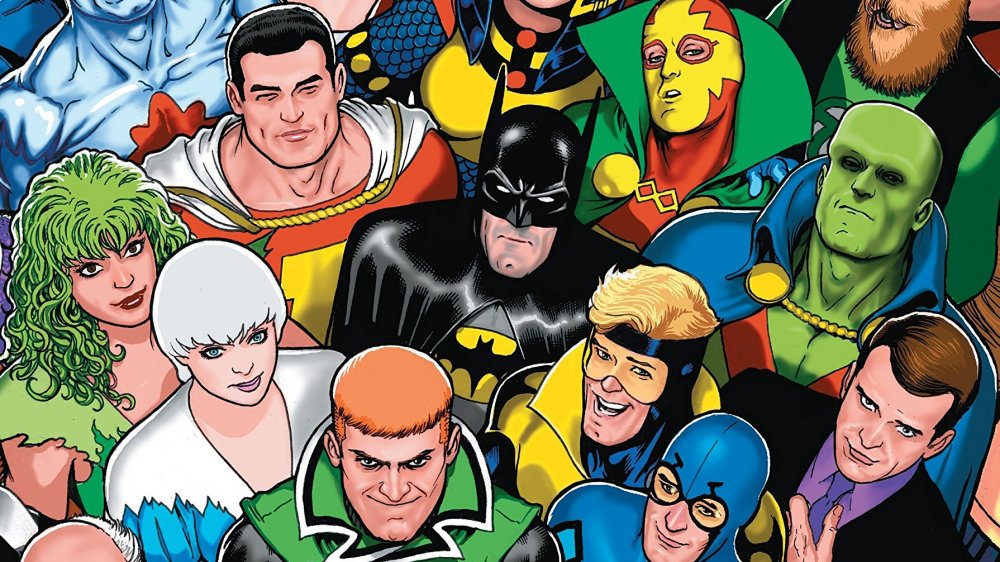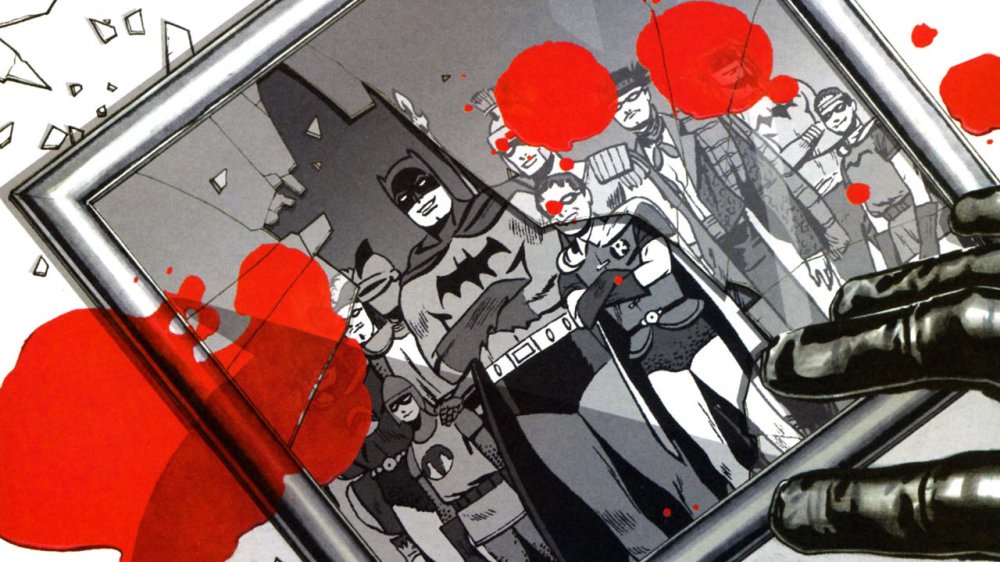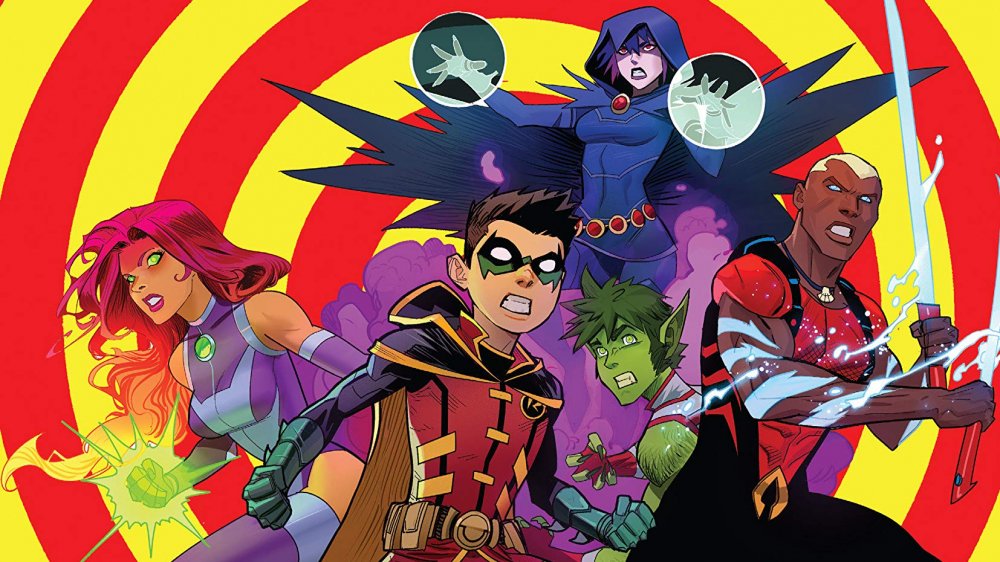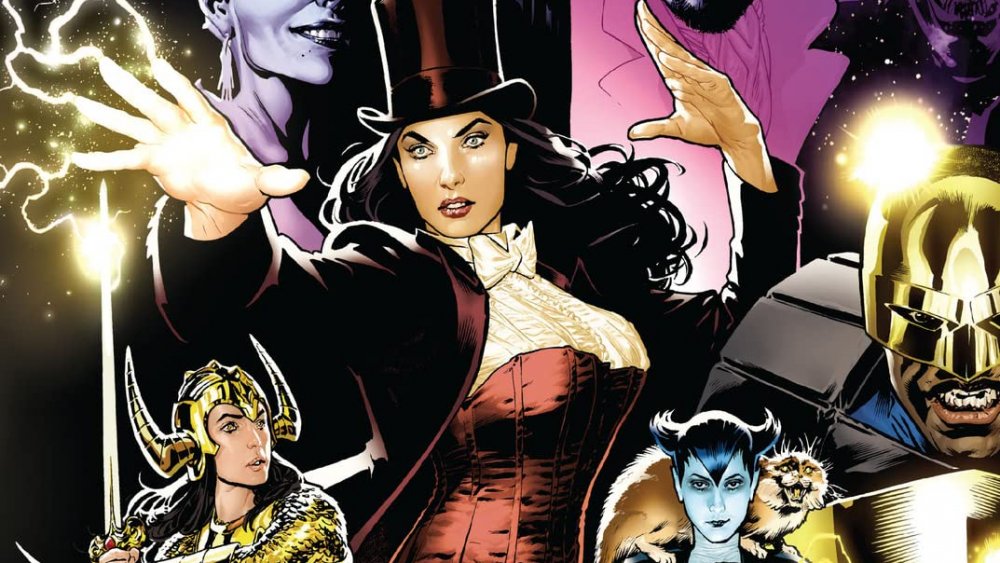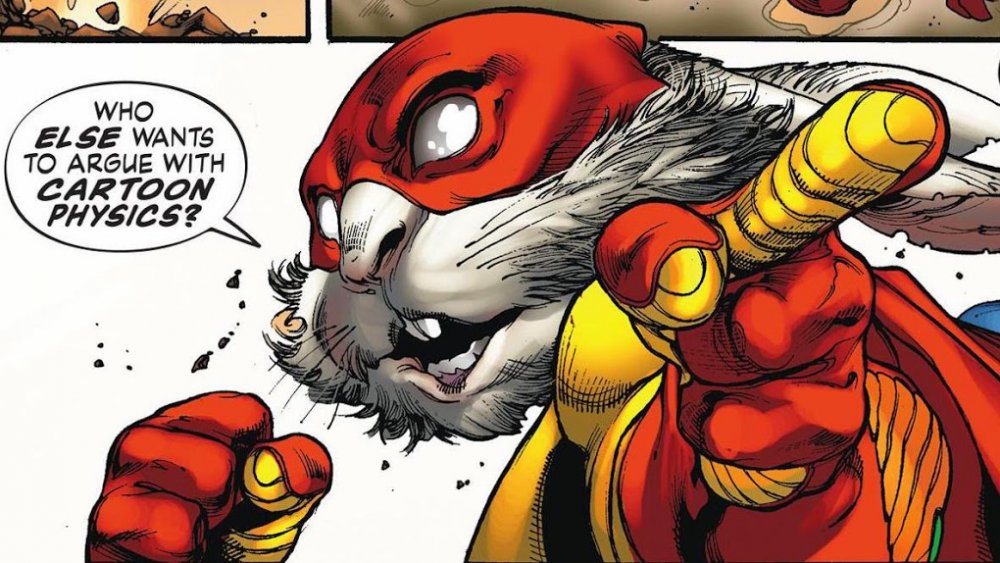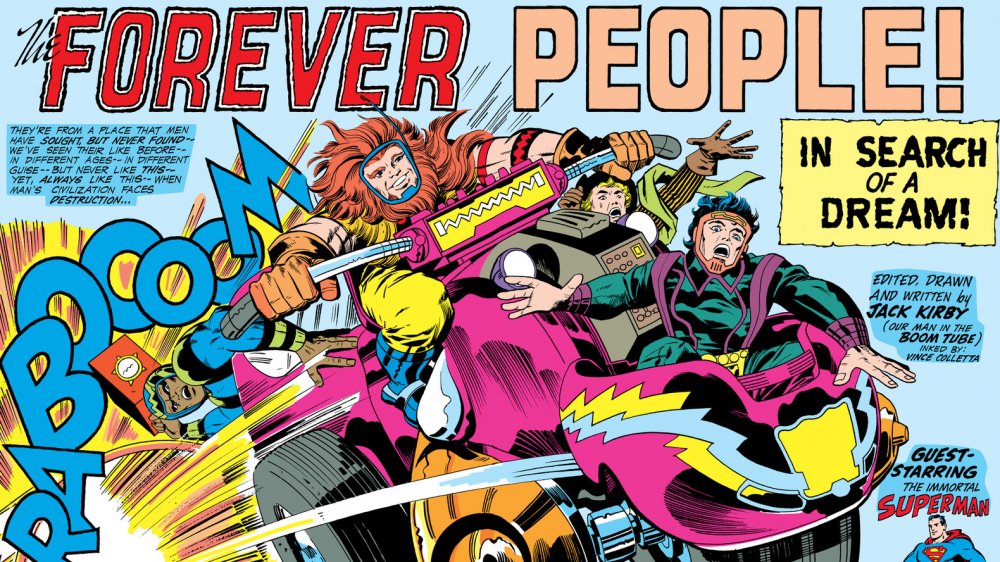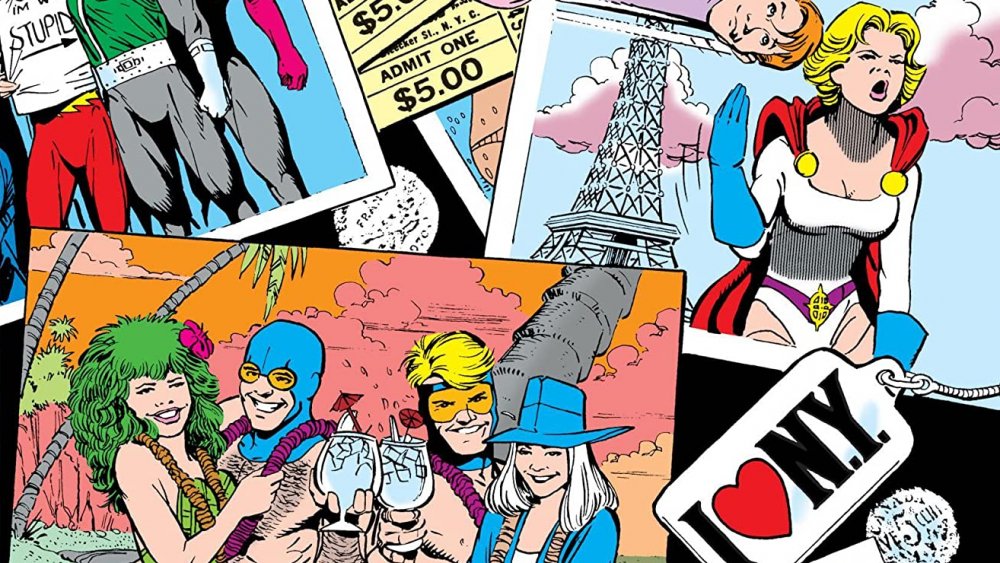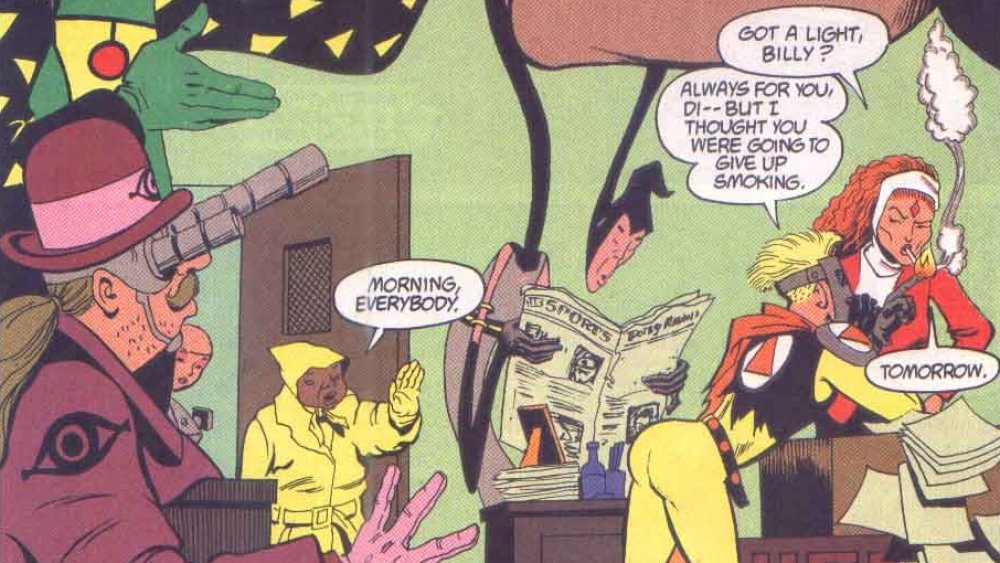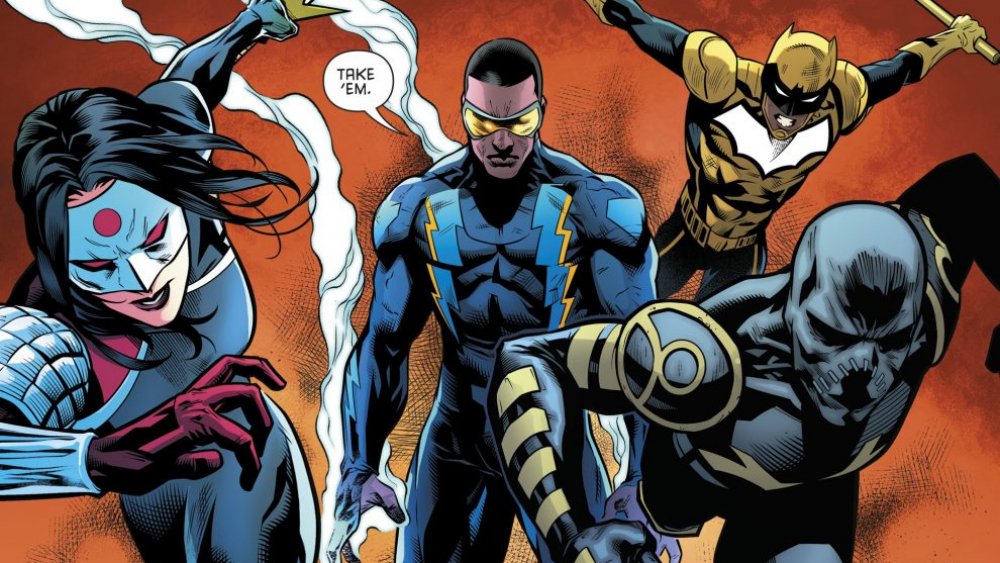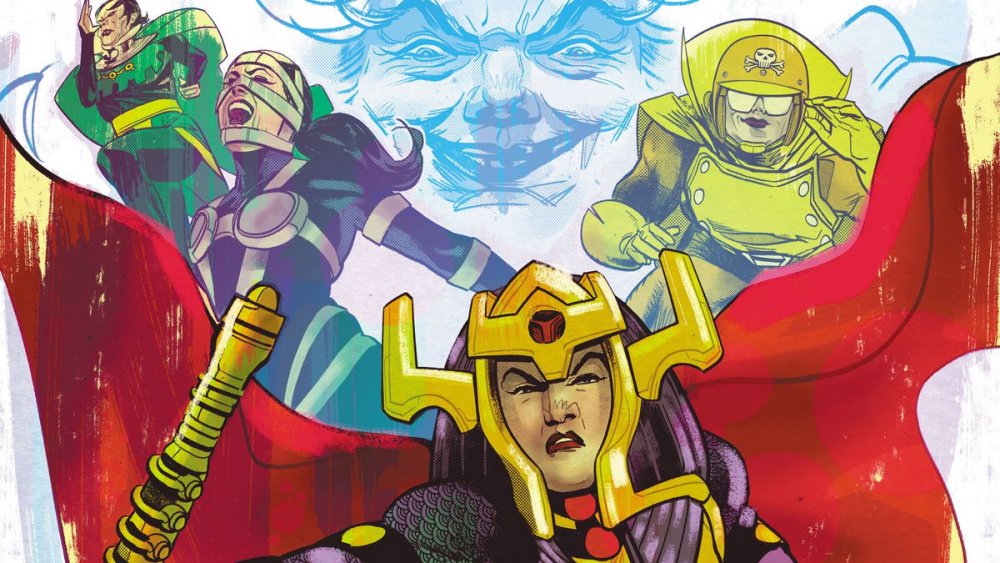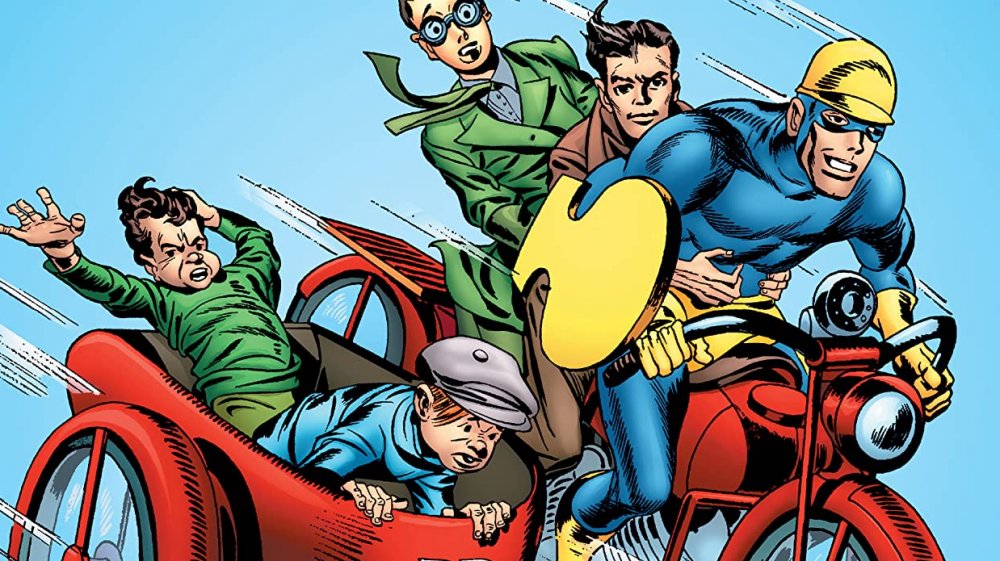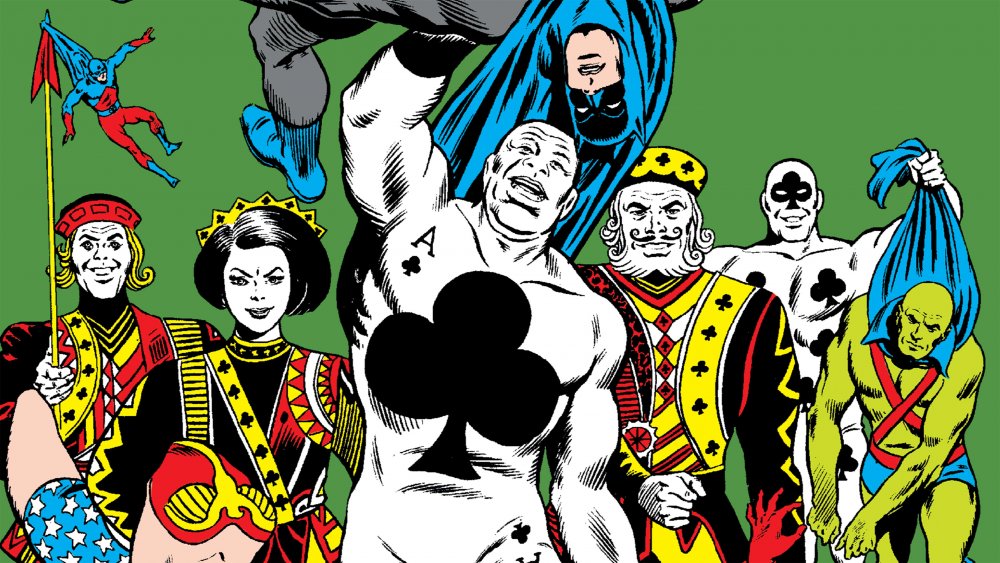DC Teams We Want To See In The DCEU
The DC Extended Universe might not yet be the planet-spanning behemoth that is the Marvel Cinematic Universe, but with blockbuster hits like Joker and Shazam!, it isn't as far behind as it may have once seemed. This is the studio with Superman, Batman, and Wonder Woman, after all — the MCU might have turned C-listers like Star-Lord into household names, but anyone in the world can identify DC's Man of Steel, no matter how panned his recent movies have been. As hype builds for The Batman and the world waits to take it back to the era of New Order and legwarmers with Wonder Woman 1984, a question emerges from the audience: What comes next?
There are any number of heroes, storylines, and mystical locales native to the pages of DC Comics that are still ripe for fresh cinematic adaptations. But as far as we're concerned, the DCEU should prioritize bringing DC's splendid super-teams up to the big leagues. Some span the stars, some pound the pavement, and some work outside of reality altogether. All of these groups of super-powered individuals are fascinating — and all could make for serious silver screen success. These are the DC teams we'd most like to see in the DCEU.
Batmen of All Nations
The Batmen of All Nations, sometimes also known as the International Club of Heroes, debuted on the comics page in 1955 — and it shows. As Detective Comics #215 has it, the legend of Batman has spread so widely across the world that imitators have emerged everywhere from Argentina to Italy. The Knight and the Squire (actually the Earl of Wordenshire and his son) clean up crime in England. Man-of-Bats and Little Raven keep their South Dakota reservation safe from all who threaten it. The Musketeer takes down Parisian ne'er-do-wells in a plumed chapeau. This is straight-up Silver Age comic book story stuff, down to the Knight and Squire's horse-shaped motorcycles.
You might think this would be a hard sell for modern audiences. But the Batmen of All Nations popped up in 2007's Batman #667, and the concept is as fresh today as it was the year it made its debut. With just a little fine-tuning — Man-of-Bats also works as a doctor, the Musketeer gets rich off selling the rights to his image — the idea of Batman-styled vigilantes the world over fits smoothly into the DC universe. The DCEU's world is a highly interconnected one, its global conversation moving at the lightspeed pace of social media. It might, in fact, be stranger to imagine a world where there aren't Batman imitators. Bring on the Batmen from every corner of the globe, and let them redefine their group once more for today's modern viewing audience.
Teen Titans
Not every incarnation of the Teen Titans has been a rousing success, but every single one has at least been interesting. The very first lineup, referred to in earnest as "the Fab Foursome?" Let down your guard and admit that if you'd been a kid in the 1960s, you'd have loved their groovy antics. The soap opera that was the 1980s New Teen Titans? Who doesn't want their superpowered teenagers served with a side of angst, romance, and betrayal? The 2003 cartoon? We'll bet money the theme song will be stuck in your head tomorrow. The wacky wonderland that is Teen Titans Go!? Oh, you mean that cartoon that made real estate investment hilarious to kindergartners and their parents?
The point is, the Teen Titans are one of the most dynamite ideas DC has ever had. Every lineup sizzles with storytelling possibility: Alien princesses, back-tackling shapeshifters, and Atlantean rebels shoved onto the same team can't help but create interesting tension. The Titans are also already a familiar property, what with the last two decades' worth of smash-hit cartoons — so why not just go ahead and bring that goodwill into the DCEU? And hey, who doesn't want to see the Titans try to explain why a T-shaped tower isn't a disastrous idea to Robert Pattinson's steely-eyed Batman?
Seven Soldiers of Victory
Originally, the Seven Soldiers were a Golden Age super-team who took on the Axis in World War II. Then, in 2005, Grant Morrison and a roster of artists revamped the team into something entirely different and absolutely wonderful. Seven Soldiers of Victory chronicles seven reluctant, second-string heroes' strange journey to coming together as a team to fight the fiendish Sheeda, an Earth-inhabiting race of the far future. What ultimately makes the story tremendously unique is its format: The series consists of two book-end issues, and between them, seven four-issue, character-specific arcs. Though every hero fights the Sheeda, they do so separately — even in the climactic final battle, they can't really comprehend the larger picture of what they are doing. In the end, the Seven Soldiers are a team that isn't, in fact, much of a team at all.
This is a balancing act of a book, and one that would admittedly challenge any filmmaker, no matter how confident. But the comic pulled it off, proving how great the reward is for taking on the premise's risk — and a movie could succeed in much the same way. It helps that the Seven Soldiers include some of DC's most colorful characters, like Zatanna and Mister Miracle. They're all a little weird, rooted in their own particular corners of the DC universe, swept up in dramas utterly opaque to everyone else in the story. Combing their unique paths into one complete, satisfying big-screen arc would definitely be a challenge, but one that would still be well worth undertaking.
The Zoo Crew
The Zoo Crew are a band of anthropomorphic animals from Earth-C, a parallel planet home to places like Mew Orleans and Piggsburgh. Their leader is Captain Carrot, known to most as mild-mannered Roger, a humble cartoonist toiling away in Gnu York City. Then Superman crashed into his reality and accidentally irradiated the carrots growing in Roger's windowbox. One bite later, and Roger was bunny-hopping his way across the city, hearing noises miles away, and discovering he had the strength of a whole warren's worth of rabbits.
The Zoo Crew ended up being DC's last "funny animal" property — but boy, did they make it count. You might not think such a wacky, childlike group has a place in the DCEU, but remember: Spider-Ham. Much as Into the Spider-Verse made audiences believe in cartoon physics as an actual superpower, Captain Carrot and his furry friends have a long history of turning their slapstick toughness into a tremendous advantage. Take the events of the entirely serious The Multiversity series, in which Carrot is plucked from his own universe to fight in a far more serious one, beside heroes from more typical DC domains. While they get burned, cut, and crushed, he is merely flattened into a coin, from which he springs back up again. Try that on for size, Steppenwolf.
Forever People
The Fourth World is one of the best parts of the DC mythos. Grand figures pontificate upon the cosmic stage, declaring themselves "the tiger-force at the core of all things." It's high drama, psychedelic science fiction, and pop mythology, all rolled up in Jack Kirby's techno-fantasia aesthetic. Characters like Darkseid and Mister Miracle have gone on to figure in searing, post-modern family dramas and vast, interstellar sagas alike. The Fourth World's characters are already set to be part of the DCEU, and will likely blow everyone's minds. But it's not all pomp and circumstance when it comes to the denizens of Apokolips and New Genesis. Enter the Forever People, flower children from beyond the stars.
There is nothing subtle about the Forever People. They spend their immortal lives "zoomin' over the electron road" in their Mother Box-powered supercycle. They're named things like Big Bear, Beautiful Dreamer, and Mark Moonrider, and they dress like they were waylaid at a Power Rangers convention on their way to Coachella. In a superhero landscape that tends toward stainless steel and desaturation, the Forever People could be a heady breath of fresh air, telling a genuinely universal teenage story. They're young, they're invincible, they're tangled up in the wars and triumphs of the adults in their lives — they're just doing it with a cosmically-powered motorcycle.
Justice League International
Is there any super-team more beloved than the Justice League? They are to comic books what apple pie is to American pastry. Justice League International, however, is not exactly the team you picture when that iconic squad of superheroes comes to mind. Assembled in the wake of Crisis on Infinite Earths, the JLI couldn't use Superman, Wonder Woman, or the Flash. They're the B-side of Justice Leagues, as a result: Batman's there, marooned in a sea of lesser-known heroes like Blue Beetle, Doctor Fate, and Black Canary.
What resulted is a zany delight. Tension among team members is unique and unexplored — who'd put Dr. Light and Guy Gardner in a room before? — and the series' unflappable sense of humor remains a breath of fresh air. JLI blends comedy with genuine heroics and keeps both parts all the more fresh by doing so. The DCEU has struggled with dour po-facedness — why not inject it with some sunlight, through a team that never forgets how to laugh at itself?
Hero Hotline
Trouble's afoot in the DC universe! But Superman, Batman, and Wonder Woman are busy — what's a terrified bystander to do? Call the Hero Hotline, of course! Available 24 hours a day, the Hero Hotline will dispatch one of its many qualified super-associates to take care of whatever you need. Run by the mysterious Coordinator, the Hotline's heroes include luminaries like Microwavabelle, Zeep the Living Sponge, and Marie, a psychic turtle sporting a truly adorable helmet.
As you might have guessed, the heroes of the Hotline are not exactly the DC universe's premier good guys. But what a concept they introduce! The Hero Hotline is unabashedly corporate, offering a unique look at how a world with superheroes might function. And though the Hotline's roster isn't the A-list, it's hard not to fall in love with them. Microwavabelle juggles inexact bus schedules alongside her scientific exploits, Mister Muscle constantly changes his name (Brother Bicep is a particularly good choice), and Stretch lives life with stretching powers that never stop working, meaning he typically looks like a wad of thoroughly chewed gum. This could be the DCEU's Guardians of the Galaxy, and a fascinating new perspective on superhero storytelling.
Outsiders
As you might have guessed from their name, the Outsiders work beyond the borders of typical superheroics. A black-ops team assembled by Batman, they can go where the Justice League can't, righting wrongs without political approval, public adulation, or really, any sort of attention at all. Accordingly, they are incredibly effective and often include members with unique powers. Here we have superheroes like Halo, a young woman from Missouri possessed by a primordial consciousness, Indigo, an android who enjoys bowling, and Looker, gifted with the grab-bag power-set of beauty, psychic abilities, and vampirism.
The Outsiders have dabbled in everything from international subterfuge to supernatural possession. This flexibility could prove to be an enormous asset to the DCEU: The Outsiders can play a role in stories centered around interstellar threats, magical mayhem, and corrupt tycoons alike. Moreover, they're Batman's team, and the DCEU's safest bet is Batman. Given the man in the pointy ears a problem he needs to solve quietly, introduce any number of interesting weirdos who've claimed Outsiders membership at some point, and you've got cinematic lightning in a bottle.
Female Furies
The Fourth World is very much part of the DCEU already, from Steppenwolf's assault on the Earth to Cyborg's Mother Box-powered cybernetic body. With a New Gods movie already in production, speculation is sizzling as to what elements of Apokolips and New Genesis will make their mark on the DCEU. We submit the Female Furies as one part of the Fourth World that simply cannot be ignored.
The Furies are sort of like Black Panther's celebrated Dora Milaje: Darkseid's elite, all-female strike force and honor guard who are, at all times, prepared to fight for their leader. Unlike the Dora Milaje, they have been raised by the ruthless Granny Goodness within the nightmare that is Apokolips, and are, as a result, completely twisted. But oh, how thrillingly theatrical that twistedness is: The Furies have names like Bernadeth, Mad Harriet, and Gilotina, rhapsodize about the chance to "earn [Darkseid's] love through pain and blood," and sometimes, in Big Barda's case, defect to Earth for a chance at love and freedom. From their bold costumes to their imaginative powers, the Furies were made for the big screen. Luckily enough, New Gods director Ava DuVernay has confirmed they will definitely be part of her movie — alongside Darkseid, of course.
Newsboy Legion
The Newsboy Legion began in the Golden Age as a group of orphans living in Metropolis' notorious Suicide Slum. They're a scrappy, rambunctious gang who sling papers and manage to get into all sorts of thrilling trouble, who go by nicknames like "Big Words" and "Scrappy." Years later, they were reintroduced and mixed up in the super-scientific corners of the DC universe, leading to a whole lot of stories involving Newsboy Legion clones and emissaries from Apokolips. They are, in short, that most classic of comic book inventions: A pretty simple concept made wildly weird by continuity, reinvention, and science so advanced as to border upon magic.
The DCEU has a smorgasbord of options to pursue, if the Newsboy Legion were to be included. They could always go classic — who doesn't like Newsies, right? But the Newsboy Legion's involvement with the Fourth World and government cloning has been part of their story for just as long as their gee-whiz golden years. That's not even the end of it, though — Young Justice: Outsiders recently reimagined the Legion as composed of newsgirls, who stream from their phones instead of slinging papers. Audiences could fall in love with any of these takes, whether decidedly old-school or totally new.
Royal Flush Gang
It isn't exactly accurate to say that the Royal Flush Gang have worn many hats over the course of their 50+ year history. They have always maintained their playing card theme, have always been bad guys, and have always favored a sleek aesthetic. But within those parameters, their portrayal has varied wildly. The Royal Flush Gang have been taken over by the Joker, worked with androids, dabbled in mind control, and been revealed as a multi-generational operation perpetrated by one seriously vile family. There's one take that the DCEU should pay particular attention to, however: the Royal Flush Gang as portrayed on Justice League Unlimited. In one of the most affecting scenes of the series, it is revealed that this incarnation of the team was created by Ace, a psychic teenager who has warped innocent bystanders into filling out the Gang's ranks. Batman is sent in to kill her before she breaks reality entirely — but all Ace wants is for someone to listen to her. Batman does, and holds her hand until she passes away naturally.
Revamping the Gang with this take on Ace at its core practically begs to be put on the big screen. Her story confronts our heroes with hard truths, while complicating the villains around her — and for all that subversion, it's a choice that still allows for all the stylish fun of classic Gang interpretations. As far as villains go, the Royal Flush Gang is a winning hand.
